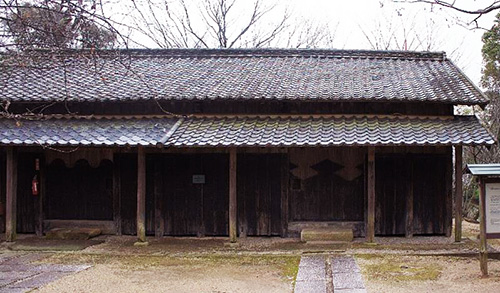


四国村野外展示で教えられた存在として「義倉」があります。
北海道の人間としてはこういう建築施設は見たことがなかった。
義倉という漢字をみて大体が想像できるように用途としては
飢饉のときにそなえて非常用の食物を蓄える目的だったとされています。
そのこと自体は社会保障の考え方のマザーと思える。
義倉の出自は以下のようなWikipedia記述、理解が一般的。
〜義倉とは中国朝鮮及び日本で要地に置かれた穀物備蓄する倉庫。
災害や飢饉に備え米・穀物を一般より徴収または富者から寄付を得て蓄えた。
非常時に備える一方で腐敗の防止と義倉維持のため古い穀物を安価で売却し、
また一般に低利で貸し付ける(借放)事も行われていた。 〜
〜中国では周が「委積法」を行ったことに由来とされるが、
記録の上で明白なのは隋の開皇8年(585年)に定義され諸侯から民衆まで
一定の粟・黍を納めさせ州県に設置の義倉に納めた。以後歴代王朝に引き継がれ
唐の天宝8年(747年)には全国に総額6,370万石の備蓄があった。
だが、不正や財政への流用などによって南宋以後には衰退した。
一方日本では隋の制度を基に大化の改新の際に導入され大宝律令賦役令で
定められ人民がその貧富に応じて納めた。律令制衰退に伴い義倉も衰退した。
江戸時代に入ると儒教の影響で諸藩の中に義倉を作る所が現れた。明治政府成立後
多くが政府に接収され不足する国家財政の穴埋めに使われた。〜
・・・ということでその発生出自として儒教的概念が色濃い。
中国で「中華思想」という為政者の独裁を称揚する思想が成立し、
その独裁政治を支え為政者に「奉仕」させる思想・儒教が社会的に重用された。
日本に導入されたのが律令国家体制導入の時期と重なって、
その後衰退したものが、江戸期幕府権力の強制でまた盛んに造営された。
どうも儒教とワンセット、儒教思想を肯定する大きな「納得材料」として
社会的な意味を持って維持管理されてきたように捉えられる。
このようにありがたい備えも指示されている皇帝さまだから
ひれ伏して従順に従って命令には決して逆らってはいけない、みたいな。
その理念に社会的意義はあるけれど「不正や財政への流用」という
権力悪の温床にもなっただろうことが容易に想像できる。
北海道は農業開発での人口集積が明治以降の150年の歴史なので、
こういう存在と縁遠いと感じるのだけれど、
四国など神代の時代からの歴史集積のある地域では
「飢饉」という社会経験知が大きく存続してきているのだと教えてくれる。
こういう社会思想がそのまま建築的に存続していることにも
深く驚かされる思いであります。建築と人間社会の関わりの大きな一側面。
English version⬇
[“Gisou” from Confucian thought in Kochi Shikoku living space exploration-18]
“Gisou” is one of the things taught at the Shikoku Village outdoor exhibition.
As a human being in Hokkaido, I have never seen such a building facility.
As you can imagine by looking at the Chinese character Gisou,
It is said that the purpose was to store emergency food in case of famine.
That in itself seems to be the mother of the idea of social security.
The origin of Gisou is generally described and understood in Wikipedia as follows.
~ Gisou is a warehouse that stores grains at key points in China and Japan.
In preparation for disasters and famines, grains such as rice were collected from the general public or donated by rich people.
Selling old grains at a low price to prevent grain spoilage and maintain Gisou while preparing for emergencies,
In general, lending (borrowing) at low interest rates was also carried out. ~
~ In China, it is said that it is derived from Zhou’s “contract method”.
What is clear on the record is that it was defined in the 8th year of the Sui Emperor (585), from the princes to the people.
It was delivered to Gisou, which was set up in the state prefecture, with a certain amount of millet and millet. After that, it was taken over by successive dynasties
It is said that there was a total stockpile of 63.7 million stones nationwide in the 8th year of the Tang Dynasty (747).
However, it declined after the Southern Song Dynasty due to fraud and misappropriation to finances.
On the other hand, in Japan, it was introduced at the time of the Taika Reform based on the Sui system, and it was appointed by the Taiho Code.
Almost all the people paid according to their rich and poor. Gisou also declined with the decline of the Ritsuryo system,
In the Edo period, due to the influence of Confucianism, a place to make Gisou appeared in various clan. However, after the establishment of the Meiji government
It is said that most of them were requisitioned by the government and used to fill in the shortage of national finance. ~
… So, the Confucian concept is strong as the origin.
In China, the idea of praising the dictatorship of the politician was established because of the “Chinese idea”.
Confucianism was socially emphasized as an idea to support the dictatorship and make the politicians “serve”.
It was introduced in Japan at the same time as the introduction of the Ritsuryo national system,
What had been declining since then was actively built again during the Edo period due to the compulsion of the shogunate power.
As a big “convincing material” that affirms Confucianism and one set, Confucianism
It seems that it has been maintained and managed with a social meaning.
Because the emperor is instructed to prepare in this way
It’s like you should never bow down and obey your orders.
Although the idea has social significance, it means “misappropriation and misappropriation for finance”.
It is easy to imagine that it would have become a hotbed.
Hokkaido has a history of 150 years since the Meiji era, because the population agglomeration in agricultural development is 150 years old.
I feel that it is far from such an existence,
In areas such as Shikoku where there is a historical accumulation from the age of the Gods
It tells us that the social experience knowledge of “famine” has continued to exist.
The fact that this kind of social thought continues architecturally as it is
I am deeply surprised. A big aspect of the relationship between architecture and human society.
Posted on 3月 3rd, 2022 by 三木 奎吾
Filed under: 住宅マーケティング, 歴史探訪







コメントを投稿
「※誹謗中傷や、悪意のある書き込み、営利目的などのコメントを防ぐために、投稿された全てのコメントは一時的に保留されますのでご了承ください。」
You must be logged in to post a comment.